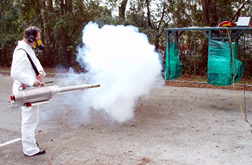This page has been archived and is being provided for reference purposes only. The page is no longer being updated, and therefore, links on the page may be invalid.
|
|
|
|
Perfecting Pesticide Applications to Protect the Troops
By Alfredo FloresFebruary 27, 2007
When deployed to foreign countries, U.S. military personnel have plenty to worry about. But, thanks to data collected by Agricultural Research Service (ARS) scientists, diseases spread by insects and other arthropods in the field can now be of less concern.
The new data can help ensure that military and public health officials will know best how to provide pest control to minimize problems caused by arthropod carriers of human and animal diseases.
Deployed military personnel are often exposed to disease-carrying insects, and they have little control over the surrounding environment. Consequently, mosquitoes, houseflies and sand flies can complete development in large numbers to produce harmful adult insects.
The ARS developed a method for dealing with this problem in the early 1960s by dispersing a cloud of fine, precisely sized droplets from a truck-mounted machine. Known as ultra-low-volume application, this technique actually reduced the amount of insecticide dispersed while increasing its effectiveness. The critical factor in pesticides' effectiveness is the size of the droplets that are dispersed.
Agricultural engineer Clint Hoffmann, in the ARS Areawide Pest Management Research Unit at College Station, Texas, used high-tech methods to measure the range of droplet sizes produced by various kinds of sprayers and products. He found considerable differences in their performance.
In addition to studying truck-mounted sprayers, Hoffmann also evaluated the characteristics of four hand-held sprayers and a backpack sprayer, testing them with water- and oil-based insecticidal solutions. As was the case with the truck-mounted versions, he found significant differences in the droplets generated by the five sprayers.
The U.S. military will be able to use these results to match the right piece of equipment to the right insect problem, thus reducing disease spread.
This work was supported by the joint efforts of ARS and the Department of Defense Deployed War Fighter Protection Program, specifically with Todd Walker of the U.S. Navy Entomological Center of Excellence in Jacksonville, Fla. Numerous manufacturers and chemical suppliers were also essential to the success of this work.
ARS is the U.S. Department of Agriculture's chief scientific research agency.

